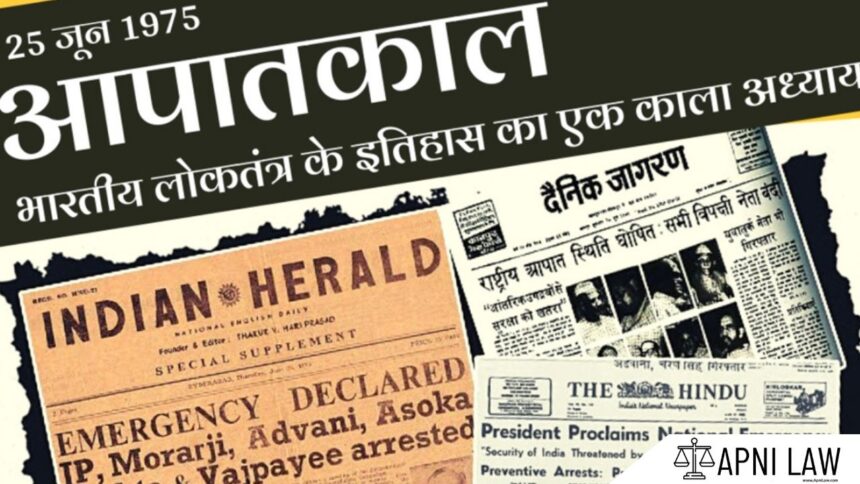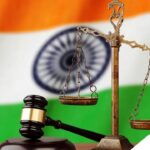This article is written by Atishay Jain, a former UPSC aspirant and a key member of the ApniLaw team, combining his knowledge of the Constitution with a strong interest in public law. For any personal queries or suggestions, feel free to reach out to us through our official channel
The Indian Constitution empowers the Union to take extraordinary measures in times of grave national crises. Among these powers is the provision of National Emergency under Article 352, which fundamentally alters the federal structure and temporarily curtails certain rights to safeguard the integrity of the nation.
Let’s understand this provision in a clear, practical manner, with reference to real events.
What is a National Emergency?
A National Emergency is declared by the President of India under Article 352 when the security of India or any part of it is threatened by:
- War
- External Aggression
- Armed Rebellion (earlier referred to as “internal disturbance” before it was redefined by the 44th Amendment)
Importantly, the threat need not be present—it can also be imminent.
Illustration: In 1971, India faced an external threat from Pakistan during the Bangladesh Liberation War. A National Emergency was declared in response to this war, enabling the Union government to take strong, coordinated actions across states.
The 38th Amendment (1975) further allowed the President to issue multiple Emergency proclamations, if different areas or reasons warranted it.
How is it Declared?
- The Union Cabinet, not just the Prime Minister, must send a written recommendation to the President.
- This safeguard was introduced by the 44th Amendment (1978) to prevent arbitrary use.
- Once proclaimed, the Emergency must be approved by Parliament.
Another critical change brought by the 44th Amendment is that the President’s proclamation can now be reviewed by courts. This was not allowed earlier.
Parliamentary Approval and Duration
- The proclamation must be approved by both Houses of Parliament within 1 month.
- If the Lok Sabha is dissolved, approval by the Rajya Sabha suffices temporarily.
- Once approved, it remains in force for 6 months and can be renewed indefinitely—every 6 months, with fresh approval.
- Special majority is required for renewal (a majority of the total membership and two-thirds of members present and voting).
Earlier, only a simple majority was required. The 44th Amendment corrected this to ensure stricter checks.
Revoking the Emergency
- The President can revoke the Emergency at any time.
- Additionally, if at least 10% of Lok Sabha members request a session, the President or Speaker must convene it within 14 days.
- The Lok Sabha can then pass a resolution disapproving the Emergency, ending it.
Effects of National Emergency
1. Centre-State Relations
- The federal structure is altered—Centre can direct states on any matter.
- Parliament can legislate on State List subjects.
- These laws remain valid until 6 months after the Emergency ends.
- The President can alter the financial allocation between the Centre and states—but only until the end of the financial year in which the Emergency ends.
This marks a shift toward a unitary system, temporarily suspending normal federal distribution of power.
2. Term of Legislatures
- The life of the Lok Sabha and State Assemblies can be extended by one year at a time, during the Emergency.
- However, the extension cannot go beyond 6 months after the Emergency ends.
Example: The term of the 5th Lok Sabha, elected in 1971, was extended twice during the Emergency of 1975–77.
3. Impact on Fundamental Rights
a) Article 358 – Automatic Suspension of Article 19
- Comes into effect during war or external aggression (not armed rebellion).
- All rights under Article 19 (freedom of speech, expression, etc.) are suspended for the duration.
- Laws passed during this time cannot be challenged for violating Article 19.
- However, once the Emergency ends, Article 19 is automatically revived.
b) Article 359 – Suspension of Enforcement of Certain Fundamental Rights
- The President can issue an order suspending court enforcement of specified rights (except Articles 20 and 21).
- The rights themselves remain in the Constitution, but courts cannot be approached to enforce them.
- The 44th Amendment ensured that Articles 20 (protection in criminal offenses) and 21 (right to life and personal liberty) cannot be suspended under any circumstances.
This mechanism can temporarily restrict legal remedies, though not the rights themselves in all cases.
Key Constitutional Amendments
| Amendment | Significance |
|---|---|
| 38th (1975) | Made Emergency proclamations non-justiciable and allowed multiple Emergency declarations |
| 42nd (1976) | Gave Emergency a broader scope, covering entire country |
| 44th (1978) | Introduced safeguards: required Cabinet’s written advice, restored judicial review, and protected key Fundamental Rights |
Final Thoughts
The National Emergency provision is a powerful constitutional tool, designed to protect the country in times of serious external or internal threat. However, its history—particularly the 1975–77 Emergency—shows how such powers can be misused in the absence of checks and balances.
That’s why the Constitution, through later amendments, introduced several safeguards to strike a balance between national security and individual liberty. Understanding this balance is essential for anyone interested in governance, law, or constitutional principles











